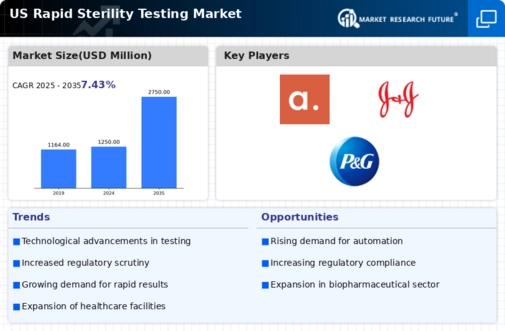Growing Awareness of Infection Control
The growing awareness of infection control practices is a significant factor driving the rapid sterility-testing market. With increasing concerns about healthcare-associated infections (HAIs) and the need for stringent sterilization protocols, healthcare facilities are prioritizing rapid sterility testing to ensure patient safety. The rapid sterility-testing market is likely to see heightened demand as hospitals and clinics implement more rigorous infection control measures. According to recent studies, HAIs affect approximately 1 in 31 hospital patients on any given day, underscoring the critical need for effective sterility testing. This heightened awareness is expected to lead to increased adoption of rapid testing solutions across various healthcare settings.
Rising Demand for Rapid Testing Solutions
The rapid sterility-testing market is experiencing a notable surge in demand due to the increasing need for quick and reliable testing solutions in various sectors, including pharmaceuticals and biotechnology. As companies strive to enhance their production efficiency, the ability to obtain sterility test results within hours rather than days is becoming essential. This shift is driven by the growing emphasis on minimizing production downtime and ensuring product safety. According to industry estimates, the market is projected to grow at a CAGR of approximately 10% over the next few years, reflecting the urgency for rapid testing methodologies. The rapid sterility-testing market is thus positioned to benefit from this trend, as organizations seek to adopt innovative testing technologies that align with their operational goals.
Expansion of Biopharmaceutical Manufacturing
The rapid sterility-testing market is significantly influenced by the expansion of biopharmaceutical manufacturing in the United States. As the biopharmaceutical sector continues to grow, driven by advancements in biologics and personalized medicine, the demand for effective sterility testing becomes increasingly critical. Biopharmaceutical companies are required to adhere to stringent quality control measures, which necessitate the implementation of rapid sterility-testing methods. The market for biopharmaceuticals is expected to reach over $500 billion by 2026, indicating a robust growth trajectory. This expansion creates a favorable environment for the rapid sterility-testing market, as manufacturers seek to ensure compliance with regulatory standards while maintaining high production rates.
Technological Integration in Quality Control
The integration of advanced technologies in quality control processes is reshaping the rapid sterility-testing market. Automation, artificial intelligence, and data analytics are increasingly being utilized to enhance the efficiency and accuracy of sterility testing. The rapid sterility-testing market is poised to benefit from these technological advancements, as they enable faster turnaround times and improved data management. Companies are likely to invest in automated testing systems that streamline operations and reduce human error. As the market evolves, the adoption of these technologies is expected to become a standard practice, further driving the growth of the rapid sterility-testing market.
Increased Investment in Research and Development
Investment in research and development (R&D) within the healthcare sector is a key driver for the rapid sterility-testing market. As organizations allocate more resources to R&D, the need for efficient and reliable testing methods becomes paramount. The rapid sterility-testing market is likely to benefit from innovations that arise from these investments, as new technologies and methodologies are developed to enhance testing accuracy and speed. Furthermore, the U.S. government has been known to support R&D initiatives through funding and grants, which could further stimulate advancements in rapid testing solutions. This focus on innovation is expected to propel the market forward, as companies strive to meet the evolving demands of the healthcare landscape.














Leave a Comment